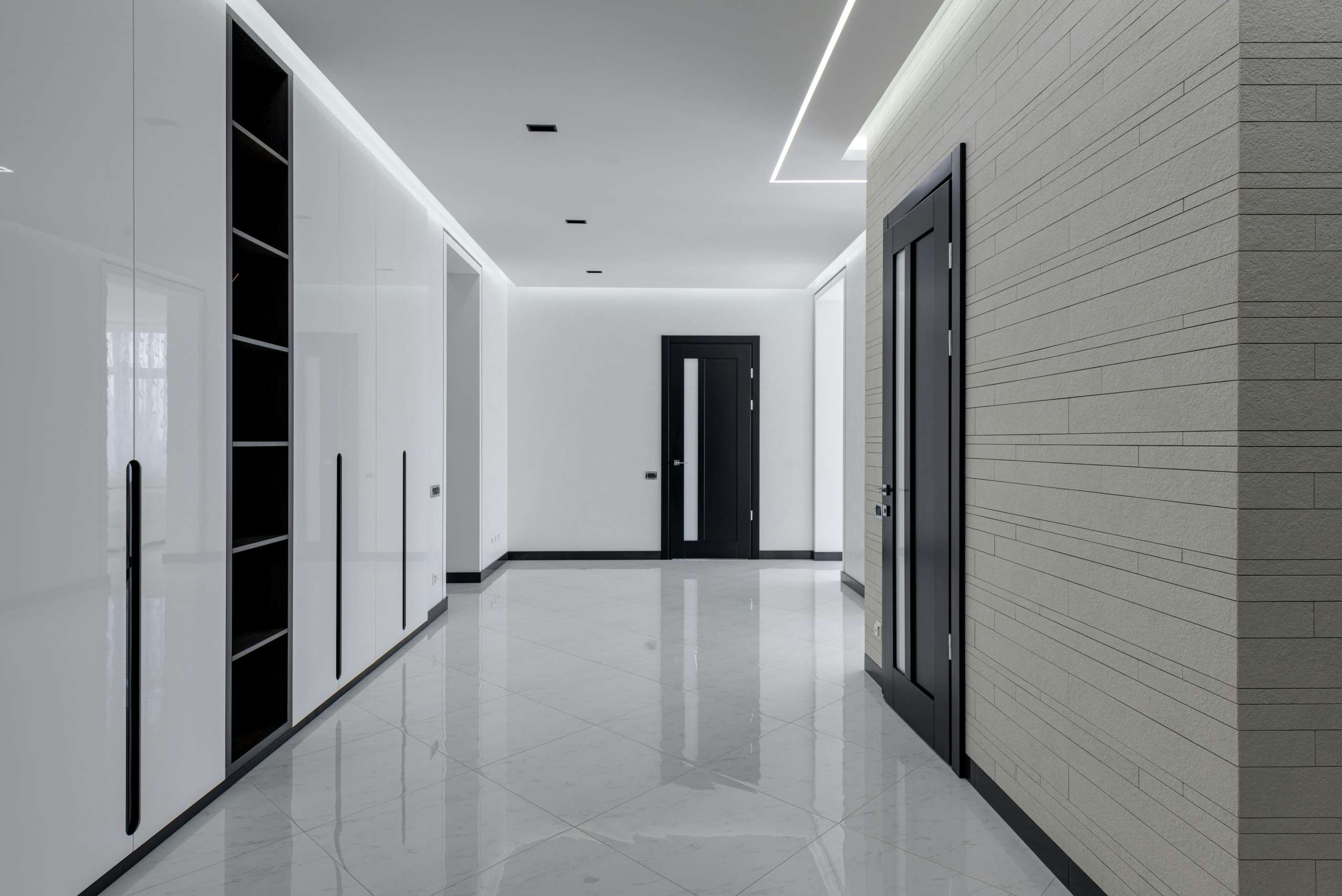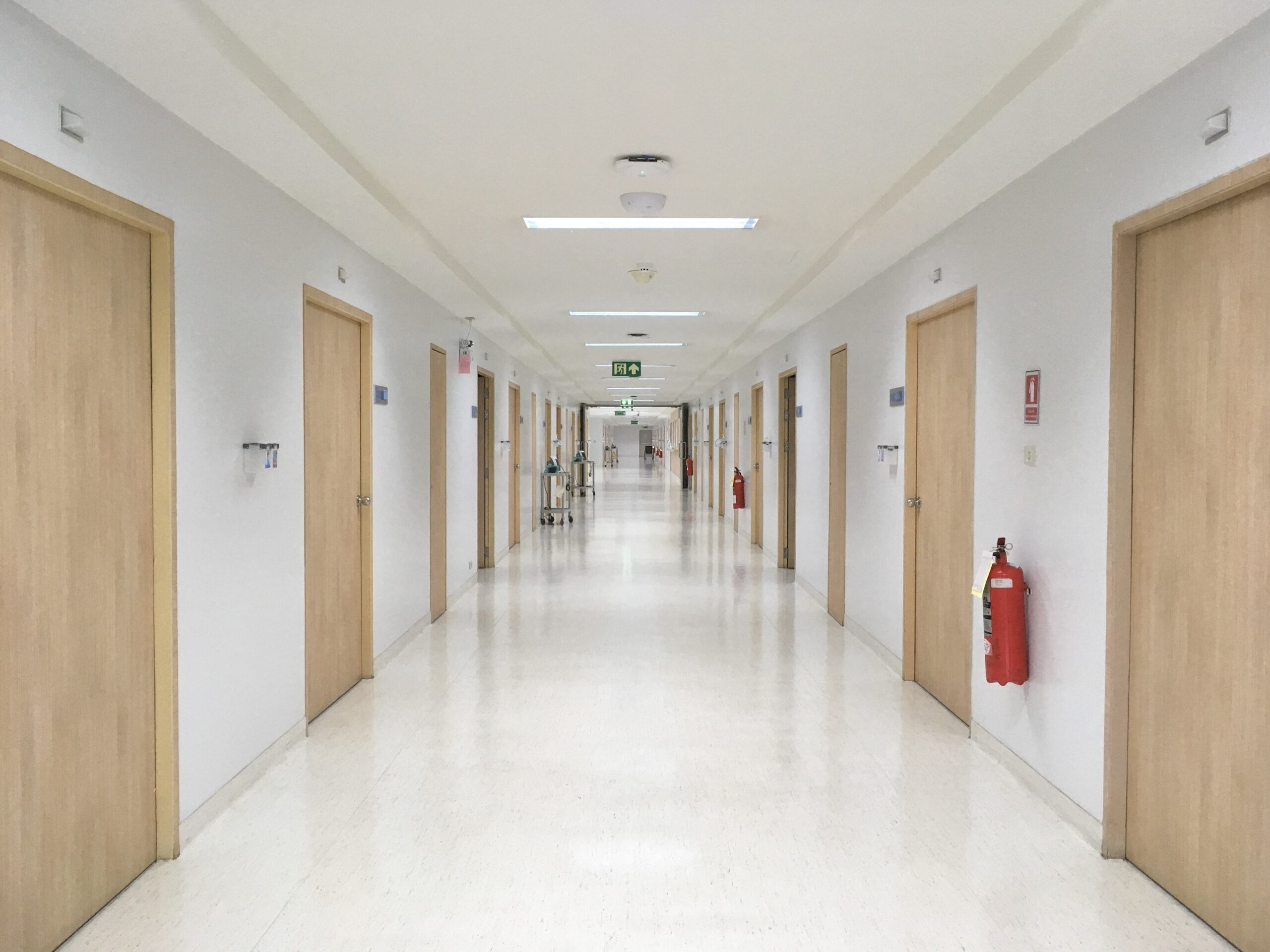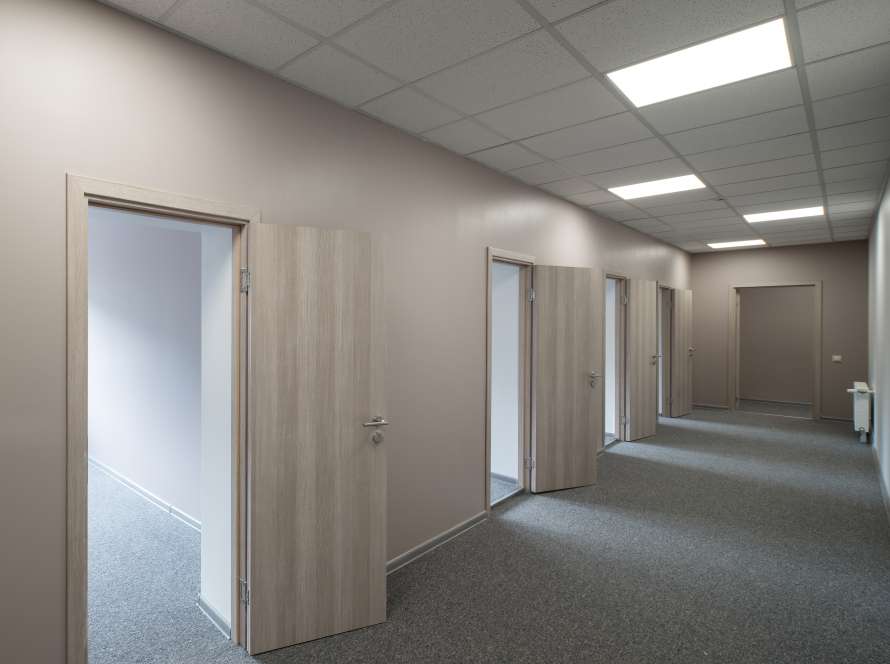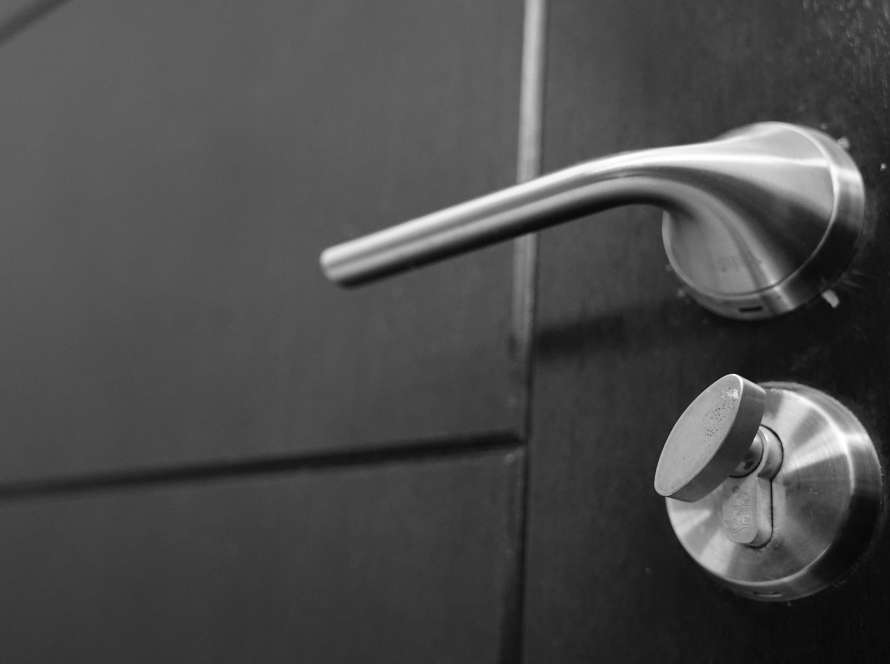When it comes to commercial construction or renovation projects, understanding the terminology related to commercial doors and door hardware is crucial for both contractors and customers. This comprehensive guide aims to clarify common terms, helping you determine the proper rough opening for a metal door frame, and ensuring the right hardware is selected for your project.
Whether you’re working with metal door frames, fire-rated doors, or specialized hardware like exit devices or cylindrical locks, this glossary is designed to assist in making informed decisions.
What Is a Commercial Door and Hardware Glossary?
This guide offers definitions for key terms in the commercial door and hardware industry, covering everything from frame gauges to lockset preparations. Additionally, we’ve included rough opening dimensions for common frame sizes, making it easier to calculate the right specifications for your installation.
Essential Terms for Commercial Doors and Hardware
12 ga., 14 ga., 16 ga., 18 ga.: These abbreviations refer to the steel gauge (thickness) of the frame and door. The higher the number, the thinner the steel.
161 Prep: Refers to a 2-1/8″ cutout in a door for cylindrical locksets.
86 Edge Prep: Refers to an 8″ cutout in the edge of a door for a mortise lock.
A
Active Door: In a pair of double doors, the active door is the leaf that opens first and contains the locking mechanism. The other leaf, known as the inactive door, remains closed until the flush bolts or surface bolts are released.
Astragal: A strip of metal or wood that covers the gap between the edges of two doors. Astragals improve the security and weather resistance of a double door setup.
Anchor: A device that secures the door frame to the surrounding structure or wall, ensuring stability and durability.
Acoustic Door: A door designed to reduce the transmission of sound between rooms, typically used in offices, conference rooms, and theaters for sound control.
Adjustable Frame: A door frame that can be adjusted to fit different wall thicknesses, offering flexibility during installation, especially in renovation projects.
Automatic Door Operator: A mechanical device that automatically opens a door when activated by a sensor or button, commonly used in AODA accessibility-compliant environments like hospitals and office buildings. Learn more about AODA Requirements
Access Doors: Specialty Doors or Access Hatches designed for restricted access areas in commercial settings, providing controlled entry for maintenance, mechanical rooms, or secure zones within commercial buildings.
B
Backset (Lock): The distance from the edge of a door to the center of the hole drilled for the lockset. Backset dimensions are crucial in selecting lock hardware for your doors.
Ball Bearing Hinge: A type of hinge featuring ball bearings between the knuckles, reducing friction and increasing longevity, especially for heavy-duty commercial doors.
Base Anchor: A metal component that secures the base of a door frame to the floor, enhancing frame stability.
Beveled Edge: An angled door edge designed to fit snugly into the door frame. This feature is particularly important for doors requiring a tight seal, such as fire-rated doors.
Ballistic Door: A door reinforced with bullet-resistant materials, used in high-security environments like banks, government buildings, or military facilities.
Butt Hinge Reinforcement: Additional metal reinforcements installed in the frame to support heavy-duty butt hinges, often required for fire-rated or high-traffic doors.
Barrier-Free Threshold: A low-profile threshold designed to accommodate wheelchairs and meet ADA (Americans with Disabilities Act) accessibility standards.
C
Cased Opening: A door frame without stops, often used in commercial spaces for a seamless aesthetic.
Closer Reinforcement: A reinforcement piece inside a door or frame that provides additional strength for mounting door closers. Proper reinforcement is essential in high-traffic areas where self-closing doors are mandatory.
Cylindrical Lock Prep (161 Prep): The standard cutout for cylindrical locksets, an essential feature in office doors and commercial facilities.
Card Reader Access Control: A security device that uses a card reader to unlock doors, commonly seen in commercial buildings with restricted access, like offices or hotels.
Commercial Door Hardware: Refers to the various components and accessories used in the installation and operation of commercial doors. This includes items such as locks, hinges, closers, panic bars, levers, and access control devices. Commercial door hardware is designed to meet the durability, security, and functionality demands of high-traffic environments like offices, schools, hospitals, and retail spaces. Hardware components are typically rated for heavy use and often need to comply with fire, safety, and accessibility codes.
Concealed Hinge: A hinge installed within the door and frame, hidden from view when the door is closed, providing a sleek, modern appearance for high-end commercial spaces.
Crash Bar: Another term for an exit device, designed for emergency egress, where pressing the bar quickly releases the latch for safe exit.
D
Deadbolt: A high-security lock that operates without spring action, ideal for commercial doors that require enhanced security, such as storeroom doors or main entrance doors.
Door Closer: A mechanical device that automatically closes a door after it has been opened, ensuring the door remains closed for fire protection or security purposes.
Double Doors: A pair of doors that close together in the middle of the frame. Double doors are commonly used in commercial buildings to provide wide entryways.
Door Coordinator: A device that ensures proper sequencing of double doors during closing, making sure the inactive door closes before the active one, essential in fire-rated double doors.
Dome Stop: A low-profile floor stop with a domed shape used to prevent the door from damaging the adjacent wall. Commonly used in commercial buildings where space is limited.
Door Sweep: A strip applied to the bottom of a door to prevent air, water, and debris from entering. Often used in exterior commercial doors for better insulation and weather resistance.
E
Electric Strike: An electrically operated device that allows a door to be opened remotely, commonly used in access control systems for office buildings or secured areas.
Exit Device: A type of door hardware designed to provide safe egress during emergencies. Also known as a panic bar, this device is essential for commercial buildings to comply with fire safety codes.
Electronic Lock: A lock operated by an electronic keypad or card reader, offering advanced security and access control for commercial offices and institutional buildings.
Emergency Exit Door: A door designed specifically for emergency egress, fitted with panic hardware, and typically required to meet fire safety regulations.
Edge Guard: A protective strip applied to the edge of a door to prevent damage from repeated impacts, common in high-traffic environments like schools or hospitals.
F
Fire-Rated Door or Fire-Rated Door Frame: These doors and frames are tested to withstand fire, preventing the spread of flames and smoke. Fire-rated doors are a must for commercial buildings, ensuring both safety and compliance with fire regulations.
Flush Bolt: A bolt installed flush with the door edge, typically on the inactive leaf of a pair of double doors.
Full Height Door: A door that extends from floor to ceiling, often used in modern commercial interiors to create a seamless design and enhance privacy.
Flush Exit Device: A type of exit hardware that sits flush with the door surface, providing a clean, unobtrusive look while maintaining fire and safety compliance.
Frame Anchor: A device used to securely fasten a door frame to surrounding structures, ensuring the frame remains stable and properly aligned in masonry or steel stud construction.
G
Gasket: A rubber or silicone seal around the door perimeter that improves weatherproofing and enhances the soundproofing of doors in office buildings.
Glazing Bead: A removable trim used to secure glass within a door frame. Glass doors in commercial spaces often require this feature to meet safety and design standards.
Glazing Stop: A removable component that holds the glass panel within a door frame, often used in vision lite doors or full-glass doors.
Grade 1 Lock: The highest durability and strength rating for commercial locks, offering the most robust security and longevity. Grade 1 locks are typically used in high-security applications like schools, hospitals, government buildings, and commercial offices, where locks are subjected to heavy use and tampering risks. These locks are tested to endure rigorous conditions, including over one million cycles of operation, making them ideal for high-traffic areas.
Grade 2 Lock: A medium-duty lock rating suitable for commercial and light industrial applications. Grade 2 locks are often used in areas with moderate traffic, such as offices, retail stores, and apartment buildings. They offer a good balance of security and durability, with a tested performance of up to 800,000 cycles. While not as strong as Grade 1 locks, Grade 2 locks still provide reliable security for most standard commercial applications.
Grade 3 Lock: The lowest durability and security rating among commercial locks, designed for residential or light-duty commercial use. Grade 3 locks are suitable for areas with low traffic and minimal security needs, such as small businesses, interior doors, or private offices. These locks are typically tested for up to 200,000 cycles, making them an economical choice for areas where high security is not a primary concern.
H
Hand (Door Hand): Refers to the direction in which a door swings, such as left-hand or right-hand. Correctly specifying the door hand is essential for proper installation of hinges and locks.
Heavy-Duty Closer: A door closer designed for high-traffic areas where doors are opened and closed frequently, often used in schools, shopping centers, and office buildings.
Hollow Metal Door: A commercial door made of metal sheets with a hollow core, commonly used in industrial and commercial environments for durability and fire resistance.
Hospital Tip Hinge: A hinge with rounded corners designed for safety in healthcare settings, reducing the risk of injury and preventing tampering in patient care areas.
High-Impact Doors: Durable doors engineered to withstand heavy use, force, and impact, typically installed in industrial facilities, warehouses, and areas requiring high durability, such as loading docks.
I
Impact-Resistant Door: A door designed to withstand strong impacts from external forces, often used in storm-prone areas or high-security applications to protect against break-ins or environmental damage.
Inactive Leaf: The leaf in a pair of double doors that remains closed and locked with flush bolts or surface bolts unless actively released. Commonly used in commercial door pairs.
Interconnected Lock: A lock that combines a deadbolt and a latch bolt, allowing both to be operated simultaneously by turning a single lever or knob. Used frequently in multifamily housing and commercial properties for convenience.
Insulated Door: A door with thermal insulation built into the core to enhance energy efficiency. Ideal for exterior commercial doors in climates with extreme temperatures.
Invisible Hinge: A type of hinge that is completely concealed when the door is closed, offering a sleek, modern look for office buildings and high-end commercial interiors.
J
Jamb Anchor: A device used to secure the door jamb to the surrounding structure, commonly used in masonry walls for added stability.
Jamb Depth: The full width of a door frame from one face to the other, often adjusted to accommodate varying wall thicknesses in commercial buildings.
Jamb Extension: A piece added to a door frame to extend its depth to match the thickness of the wall, ensuring proper installation of doors in remodeled or renovated spaces.
Jamb Weatherstripping: A weatherproofing material applied to the door jamb to seal the gap between the door and frame, commonly used in exterior doors to improve energy efficiency.
Jimmi-Proof Lock: A type of surface-mounted deadbolt designed to resist forceful entry attempts such as prying or jimming, often used in commercial buildings or retail spaces for added security.
K
Kick Plate: A protective metal plate attached to the bottom of the door to prevent damage from foot traffic, carts, and other impacts. Common in restaurants, warehouses, and office buildings.
Key Override: A feature that allows a mechanical key to override an electronic access control system, providing access in case of power failure or system malfunction.
L
Latch Bolt: A spring-operated bolt that holds a door closed, usually operated by a lever handle or knob.
Lite: A window or glazed panel within a door, enhancing visibility and natural light. Vision lites are commonly used in office doors and commercial entryways.
Low-E Glass: Glass with a special coating that reduces energy loss by reflecting heat, commonly used in commercial doors with vision lites to improve energy efficiency in office buildings.
Laminated Core Door: A door with layers of materials bonded together to enhance strength and durability, often used in high-security commercial applications or fire-rated door systems.
Latch Guard: A protective shield installed on the latch area of a door to prevent tampering or forced entry, typically seen in high-security commercial doors.
M
Mortise Lock: A heavy-duty lock installed inside a cavity in the door. Mortise locks are commonly used in commercial buildings for added security and durability.
Magnetic Lock (Maglock): A locking device that uses magnets to secure the door, often integrated into access control systems for commercial offices and high-security buildings.
Mortise Cylinder: A cylinder lock mechanism that fits into a mortise lock, offering higher security and durability than standard cylindrical locks, commonly used in commercial doors.
Motion Sensor: A sensor that detects movement and triggers the automatic opening of a door, widely used in commercial facilities for hands-free entry and accessibility.
N
Night Latch: A type of lock designed to automatically lock the door when it is closed, requiring a key to open from the outside, commonly used in commercial offices and residential properties for additional security.
Non-Handed: Refers to door hardware that can be installed on either left-hand or right-hand doors, making it versatile for any commercial or residential application.
No-Through-Bolt Hardware: Hardware that does not require bolts that penetrate through the door, offering a cleaner appearance for interior commercial doors or high-end retail spaces.
Narrow Stile Door: A door with slim vertical edges, often used in glass storefront systems for a sleek, minimalistic appearance while maximizing glass surface area.
Non-Removable Pin (NRP) Hinge: A hinge that prevents the removal of the hinge pin when the door is closed, commonly used in exterior doors or security doors to prevent tampering.
O
Offset Pivot Hinge: A type of hinge where the pivot point is offset from the door edge, allowing for wider openings, often used in heavy commercial doors or glass doors.
Overhead Concealed Closer: A door closer hidden within the door frame, providing a seamless look while maintaining automatic door closing functionality. Commonly used in high-end commercial buildings.
Opening Force: The amount of force required to open a door, important for meeting ADA (Americans with Disabilities Act) requirements in commercial spaces.
O-Ring Gasket: A circular sealing component used in various door hardware applications to provide a tight seal, commonly seen in weatherproof or fire-rated commercial doors.
Obscure Glass: A type of glass that has been treated to reduce visibility, commonly used in bathroom doors, conference rooms, or office partitions for privacy while still allowing light to pass through.
P
Pre-Hung Door: A door that comes pre-mounted within its frame, simplifying installation and ensuring proper alignment, often used in new construction projects for commercial buildings.
Push/Pull Plate: A metal plate mounted on the door’s surface to protect it from wear, commonly found in commercial kitchens, restrooms, and medical facilities where doors are frequently opened manually.
Pivot Hinge: A type of hinge that allows the door to pivot on a point at the top and bottom, offering smooth operation and often used for glass doors or large entryways.
Q
Quick Release Panic Bar: A panic bar that releases instantly when pressed, allowing for fast egress in emergency situations, typically used in fire exits or emergency doors in commercial buildings.
Quarter-Turn Latch: A simple latch mechanism that secures the door with a quarter turn of a handle or key, used in industrial doors or equipment enclosures.
Quiet Closer: A type of door closer designed to operate silently, often used in offices, libraries, and medical facilities where noise reduction is important.
Quick Connect Hinge: A hinge system that allows for fast door installation and removal without tools, often used in modular commercial spaces or temporary installations.
Quarter Light: A small vision lite or window in a door, typically located in the upper or lower corner, used in office doors and residential entryways to provide light and limited visibility.
R
Rough Opening: The size of the opening in the wall into which a door frame is installed. Correct rough opening dimensions are critical for the proper fit of your commercial door frame.
Reinforced Door Core: A door core with added materials like steel or wood for extra strength, typically used in high-traffic areas and commercial entrances for added durability.
Rim Cylinder: A lock cylinder typically used in conjunction with exit devices and panic bars, providing easy installation and enhanced security in commercial door systems.
Rabbeted Frame: A door frame with a recessed groove that allows the door to fit snugly when closed, improving security and insulation in commercial door assemblies.
S
Self-Closing: Doors that close automatically, often required for fire-rated doors and security doors in commercial settings.
Seismic Anchor: A specialized anchor designed to secure door frames in regions prone to earthquakes, ensuring the frame remains stable during seismic activity.
Solid Wood Doors: Commercial Doors made from a solid piece of wood or multiple layers of wood veneer, offering a premium, traditional aesthetic often used in high-end commercial spaces, offices, or residential applications.
Surface-Mounted Closer: A door closer installed on the surface of the door or frame, offering easy installation and adjustability, commonly used in commercial offices and public buildings.
Strike Plate: A metal plate installed on the door frame that engages with the latch bolt, ensuring proper alignment and security for the door, often seen in commercial lock installations.
T
Threshold Gasket: A gasket installed at the door threshold to improve weatherproofing and energy efficiency, commonly used in exterior commercial doors.
Tamper-Resistant Screw: A type of screw that requires a special tool for removal, used in high-security doors to prevent unauthorized tampering or disassembly.
Transom Panel: A panel above the door that allows light to enter a room, often used in commercial entryways for aesthetic and practical purposes.
U
Undercut: The distance between the bottom of a door and the finished floor, important for determining clearance in commercial door installations, particularly with flooring transitions.
Universal Hardware: Door hardware that can be installed on a variety of door types, designed for maximum flexibility in commercial door applications such as locksets and closers.
Upgraded Core: A reinforced door core, often made from steel or other durable materials, providing enhanced security and soundproofing in commercial settings.
U-Shaped Door Sweep: A type of door sweep with a U-shaped profile that wraps around the bottom of the door, offering excellent protection from drafts, dust, and moisture in exterior doors.
Utility Door: A door designed for non-public areas such as mechanical rooms, janitor’s closets, or storage areas in commercial buildings. Typically more durable and functional than aesthetically focused.
V
Vision Lite: A window or glazed opening within a door. Vision lites enhance safety by providing visibility, often required in hospital doors and office doors.
Vandal-Resistant Lock: A lock designed with features to prevent tampering and vandalism, used in public restrooms, schools, and government buildings.
Vision Lite Kit: A kit that includes a glass panel and framing for installation into a door, allowing for visibility while maintaining security, common in office doors and healthcare facilities.
W
Weatherstripping: A material applied around the perimeter of doors to create a tight seal against air, water, and dust, crucial for energy efficiency in exterior commercial doors.
Wire Glass: Glass that contains a wire mesh embedded within it, commonly used in fire-rated doors to prevent the glass from shattering during a fire.
Wrap-Around Plate: A protective metal plate that encases the door lockset area to provide additional security, commonly used in commercial doors to prevent tampering or damage.
Wide-Stile Door: A door with wider vertical edges, providing added strength and durability. Often used in high-traffic commercial spaces or areas requiring heavy-duty doors.
Welded Frame: A door frame where all joints are welded for maximum strength and durability, typically used in high-security applications or industrial buildings.
X
X-Ray Door: A specialized door fitted with lead lining to block radiation, used in medical facilities such as X-ray rooms and radiology departments.
Exit Device (Type X): A specific type of panic hardware designed to meet the most stringent fire and safety codes, often used in hospitals or schools.
X-Brace Reinforcement: A diagonal bracing system added to hollow metal doors for extra structural support, commonly used in industrial facilities or areas with high wind load requirements.
X-Lock: A high-security locking mechanism designed for doors in sensitive or high-risk environments such as laboratories or secure government facilities.
X-Factor: Refers to the fire resistance rating or impact resistance of a door, a key factor in determining door selection for fire-rated or high-security commercial doors.
Y
Yoke Hinge: A specialized hinge with a U-shaped yoke that allows for easier removal of the door, commonly used in industrial environments where frequent door removal is required for maintenance.
Yale Lock: A popular brand of commercial locks known for its reliability and security, often used in office buildings and commercial properties.
Yoke Latch: A type of latch with a U-shaped bar that secures the door in place, commonly used in gates and industrial enclosures for its simplicity and durability.
Yielding Hinge: A hinge designed to absorb impacts and reduce damage to the door or frame, ideal for high-traffic areas like warehouses or loading docks.
Yellow Safety Marking: High-visibility marking applied to the edges of glass doors or frames to enhance safety and prevent accidents in commercial spaces with high pedestrian traffic.
Z
Z-Bar Astragal: A Z-shaped astragal that overlaps between a pair of doors to seal the gap, commonly used in double doors to improve weather resistance and security.
Z-Clip: A fastening device used to secure panels or door hardware components, often used in modular systems for easy installation and removal in commercial buildings.
Zinc-Coated Steel Door: A steel door with a protective layer of zinc to prevent rust and corrosion, commonly used in exterior commercial doors in industrial settings.
Zero-Clearance Door: A door designed with minimal gap between the door and the frame, providing better soundproofing and fire resistance in commercial and industrial applications.
Z-Wave Lock: A smart lock that uses Z-Wave technology to communicate with other smart devices, often used in commercial buildings for remote access control and security monitoring.
Conclusion
Understanding the terminology associated with commercial doors and door hardware is essential for successful project execution. From specifying the correct rough opening size to choosing the right type of lock or hinge, this guide is your resource for accurate installations and informed decision-making.
Whether you’re installing fire-rated doors, double doors, or access control systems, this glossary will help ensure your project meets all requirements for safety, functionality, and design.
About Ontario Commercial Doors
At Ontario Commercial Doors Ltd., we pride ourselves on delivering top-quality commercial door solutions to meet the diverse needs of businesses across Ontario. With a commitment to exceptional service, high-performance products, and expert installation, we ensure that your commercial spaces are secure, functional, and aesthetically pleasing. Whether you’re looking for durable entry systems, fire-rated doors, or specialized hardware, Ontario Commercial Doors Ltd. is your trusted partner. Let us help you build a safer, more efficient, and professional environment. Contact us today to learn how we can assist with your next project!




